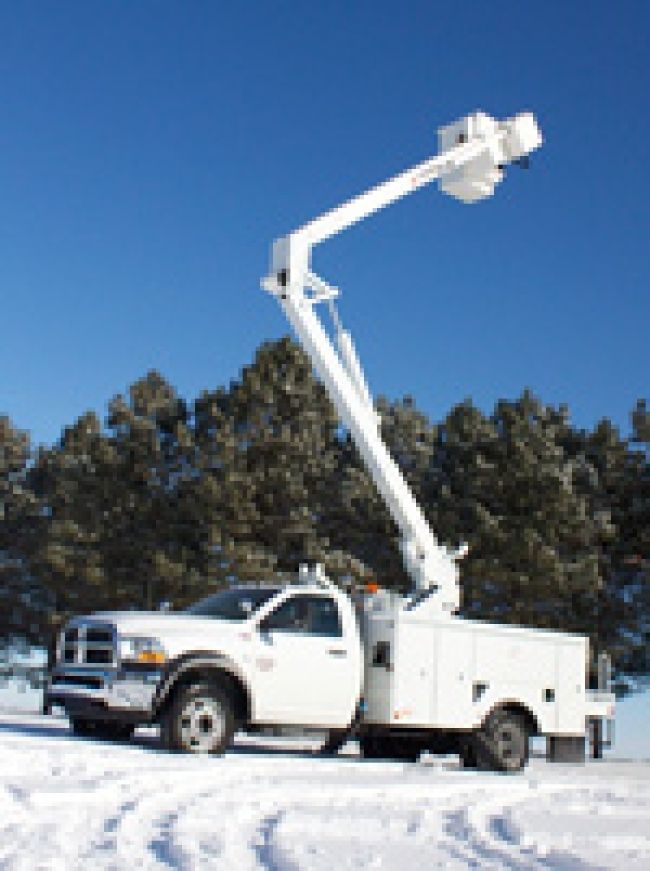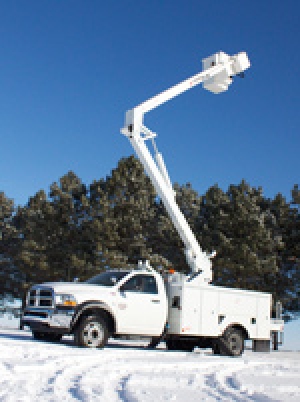
Working in Winter

No matter what time of year you are operating your utility truck, there are always best practices to follow for safe setup, operation and transportation. Particularly in colder weather when temperatures drop below freezing and stay there for an extended period of time, there are some specific things you need to keep in mind in order to keep your truck running and your crews productive.
“When it comes to working in the winter, all the same practices for safe operation apply,” said Jim Olson, product and safety engineer for Terex Utilities. “It is important to always follow the safety guidelines provided by the manufacturer in your truck’s operator’s manual. For example, you should never exceed the rated capacity of the machine, and you should never operate a truck that is damaged or malfunctioning.
“You need to be aware of how weather conditions can affect the operation of your machine and the conditions of the job site,” continued Olson. “Operating in extreme temperatures requires extra precautions.”
Temperature
According to Olson, when you conduct your job site survey, it is always critical to observe the ambient conditions, including temperature. It is important to use oils that are suitable for the ambient temperatures you will encounter. Dropping temperatures can significantly impact your aerial or digger derrick’s oil viscosity. When starting work in cold temperatures, the oil may be thick and sluggish, so it may not move fast enough to adequately feed the pump – and a starved pump can cause severe damage to your truck’s hydraulic system.
“Oils are engineered for certain uses,” said Olson. “Each oil has its own set of properties that allow it to work best in an intended application. For example, there are oils specifically designed for use in extreme temperatures – over 100 degrees Fahrenheit and below 10 degrees Fahrenheit. Terex utility trucks, for example, are set up to use ISO 15 hydraulic oil, which works well to minus 20 degrees Fahrenheit. In extremely cold conditions, the addition of reservoir oil heaters may be required.”
In addition to having the proper oil for working conditions, Olson recommends that you allow the truck’s hydraulic system to fully warm up before operating when working in temperatures below 10 degrees Fahrenheit. This means operating the pump at idling speed to allow the oil to warm up gradually and letting the oil circulate in the system by cycling each function several times before operation. The cold temperatures also affect the flexibility of the hoses; cold hoses can be very stiff and difficult to flex until they are warmed by the oil.
“The weather affects the responsiveness of your truck. The equipment, particularly the controls, will feel as if they are working in slow motion until the hydraulic system is warmed up,” said Olson. “Warm-up time will depend on the type of oil you are using, the amount of work being done and the ambient temperature.
“Operate the boom and functions slowly to prevent jerking and shock loads,” continued Olson. “And, allow more time and distance when you are starting and stopping movements.”
Wind
Wind speed is also an important factor in the safe operation and setup of your utility truck. OSHA 1910.269(x)(5) allows the use of aerial devices and digger derricks up to a wind speed of 30 mph. The OSHA general duty clause also requires that the operator determine if conditions are safe before proceeding with the work.
Olson notes utility trucks should never be operated at any wind speed that would create a potential hazard or does not allow safe operation for work to be performed. A general rule for safe wind speed cannot be applied – the on-site crew members are the only ones who are able to determine if the work can be performed safely. Gusty winds will cause equipment, power lines and poles to move at different rates that can cause them to sway closer together, which could create a potentially hazardous situation.
“Always account for windy conditions during your job site hazard assessment,” said Olson. “In the winter, you need to be aware that wind and snow can cause blizzard-like conditions, and that wind can quickly turn ice formed on power lines and trees into flying or falling debris.
“Be sure to continuously monitor job site conditions,” continued Olson. “If conditions adversely change, you must halt all operations until it is again safe to operate your utility truck. Your crew’s safety is most important.”
Snow and Ice
Operating on snow and ice adds unique challenges when working in the winter, according to Olson. Because normal traction is greatly reduced, slippery conditions can create a potentially hazardous situation for both you and your truck.
“Just as you need to maintain traction to walk and drive, you also need to maintain your truck’s stability during operation,” said Olson. “Because sudden rotation and movements of the booms can cause a truck to possibly move, if the truck is not set up securely it can slide on ice and snow while operating. Operate your truck smoothly by ‘feathering’ the controls so that all initial and final boom movements are performed at the lowest practical speed.”
A general rule for winter weather operation is to avoid setting up on snow or ice if at all possible. Because snow and ice will be on your job site during the winter months, you may need to remove snow and ice down to the bare ground to gain traction and to prevent sliding. Putting down mats, rock, gravel or sand will also help. Also, you should always use wheel chocks to help prevent the vehicle from moving.
Snow and ice can build up on the truck during transportation and operation, says Olson. If there is snow on the outrigger pads when the outriggers are lowered, the pressure can pack down the snow and turn it to ice. It’s important to check your equipment and to remove any snow or ice that accumulates. This will help reduce the risk of slip-and-fall accidents.
When setting up your truck, choose a location that gives it the best stability for the work to be done, advises Olson. It is also important to move as far as required onto the street or road so if your truck does move during operation, the tires and outriggers will not slide down a slope into a ditch, manhole or other hazard.
“If the roads around your job site have not been cleared sufficiently for safe operation, do not start work,” warned Olson. “Always understand the capability and potential hazards associated with the supporting surface prior to setup.”
Protect Your Investment
Utility truck manufacturers like Terex spell out all of the guidelines to work safely and productively in cold temperatures and winter weather conditions in your truck’s operator’s manual, but Olson suggests that your company also needs to have specific cold-weather working policies in place for crews to reduce the risks of frostbite and increased fatigue.
Your crews’ policies need to include guidelines on everything from proper attire and the use of safety equipment like harnesses, lanyards and traffic signage, to conducting preventive maintenance checks and repairing or replacing any damaged items on the truck immediately.
“Increase the efficiency and productivity of both your crew and your utility truck by setting expectations now to create safe working practices and conditions in the coming months,” said Olson.
About the Author: Amber Reed writes for Performance Marketing and services clients in the construction and utilities industries, including Terex Utilities.

